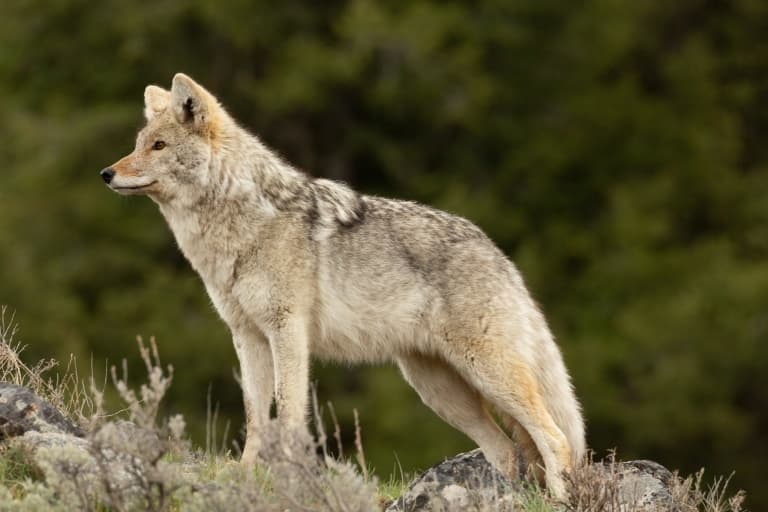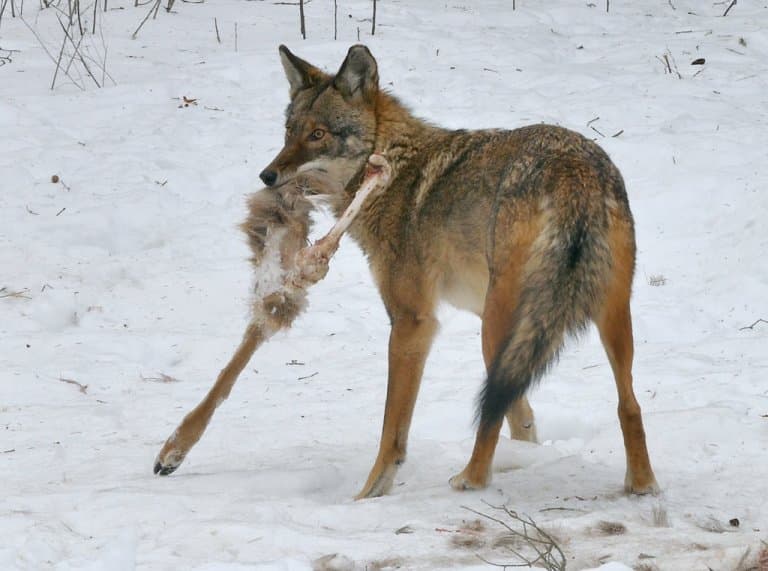Coywolf Profile
The name coywolf is an informal term for a hybrid of a coyote and a gray wolf.
With the historical persecution of wolves in the Northern Hemisphere and a relentless effort to eliminate all wildlife habitat for agriculture, coyotes in North America appear to have teamed up with their cousins to create a race of super-canids, combining the best bits from each lineage to create a dog that’s far more than just the sum of its parts.
They can also be called a ‘wolfote’ which would technically be the offspring of a wolf father and coyote mother, though this is less commonly used.
Both species belong to the same genus, so are closely genetically related and can interbreed in Northern America and Canada.

Coywolf Facts Overview
| Habitat: | Varied: cold climate, forest, urban, grasslands |
| Location: | North-Eastern US, Canada |
| Lifespan: | Unknown, possibly 10+ years |
| Size: | Up to 1.5m (5ft) long |
| Weight: | 20kg (45lb) |
| Colour: | Grey, brown, black |
| Diet: | Omnivorous hunters/scavengers |
| Predators: | None |
| Top Speed: | Unknown |
| No. of Species: | Hybrid |
| Conservation Status: | Not listed |
Coywolves live up to their name as intelligent variants of two wild canid species.
Their bizarre success is a testament to evolution and these rare hybrids appear to have what it takes to exploit new niches opened up by the sprawling destruction of human development.
There’s some variety in coywolves, including Eastern coyotes, red wolves and eastern wolves, northwestern wolves and Mexican wolves. These canids have 78 chromosomes, which allow them to interbreed between species.
Typically larger than coyotes and smaller than wolves, they have a range of attributes both individually and across their population, suggesting they might succeed as an early form of adaptive radiation of a new lineage of canid.
Interesting Coywolf Facts
1. They’re adaptable
Hybrid animals are usually a runty by-product of a biological last resort; weaker and more vulnerable in terms of evolutionary fitness, and not as good at filling the niches of either of the parent species.
But coywolves are a bit of a different breed. They’re lucky enough to have both the size and intelligence of their sires, seemingly combining the best traits of both to succeed in an otherwise under-exploited niche.
But more than this, they have their own genetic flukes. This combination of traits has given the coywolf advantages over the parent species in terms of where it can live and what it can eat.
They may even have more flexible breeding seasons than their ancestors, and can certainly produce viable offspring for healthy generations to propagate.
Everything points to the coywolf being an animal with increased ecological and evolutionary fitness over both the coyote and the wolf, and this holds a lot of potential for their success. 1

2. Coywolves have a hybrid howl
A unique set of vocalisations mean they have their own community voice.
The coywolf has a hybrid howl, where it begins sounding like a wolf, and ends with the high-pitched yipping of a coyote!
3. They’re surprisingly diverse
This success stems from a wealth of genetic material, not only giving them flexibility on the individual level but across the variant communities, too.
Coywolves come in a range of shapes, sizes and colours, and this diversity gives them an added chance of success as they experiment with new niches.
While wolves prefer forests, coyotes prefer hunting in the open. Coywolves can pick and choose. They’re also great scavengers, which makes them ideal candidates for urban cleanup crews.
4. They’re very happy in urban environments
One of these adaptations is an apparent lack of concern for human presence.
Coywolves are particularly adept at living among urban humans. Like foxes, these are a group of animals that can thrive on our wasteful practices and make up a minority of success stories in a world full of struggling wildlife.
But unlike foxes, these are genetically distinct from their wild predecessors, perhaps one of the pioneers of a new ecosystem of Anthropocene specialists.
Coyotes themselves have been known to learn traffic rules well enough to safely cross streets in busy towns and cities, and the coywolf appears to have this streetwise approach already, as an increasing number of coywolves are being filmed inside city boundaries in Eastern North America.
5. They’re incredibly elusive!
These incredible hybrids are rarely spotted, even in urban areas such as New York city are not aware of small family units near parks.
Residents will often not be aware of their existence, as they cleverly go about their lives in the background away from the spotlight.
6. They’ve even got some dog in them
Coywolves are typically known to be half wolf and half coyote, but recent DNA analyses have shown that some populations have German Shepherd and Doberman in them.
This isn’t entirely surprising, as the domesticated dog is essentially a subspecies of the grey wolf Canis lupus, which makes up half the coywolf hybrid, but it goes to show that this variant is dead set on gathering up as many canid attributes as it can.
While the coywolf is far more ecologically similar to the urban coyote, they may have some advantages that make them more competitive, and this could cement them as a new player in an increasingly human-centric ecosystem.
Still, a large coywolf is as likely to eat a domestic pet as it is to mate with one of them. 2
7. They may become a new species
This hybrid is a perfect example of evolution in practice and a demonstration of the flexibility and limitations of the species concept.
Speciation events occur as a result of changes in needs. While hybridization can slow the occurrence of new species by changing genes back and forth, it can also accelerate it. But it’s worth noting that there is no universal definition of a species, and it remains a generalistic way of classifying life.
DNA analysis consistently shows that all existing red wolves carry coyote genes for example. But hybrids are not usually thought of as a species, and red wolves are often considered as a subspecies of the gray wolf for that reason, which is subject to plenty of debate between experts.
In non-African humans, a portion of DNA is attributed to a different species of human, Homo neanderthalensis. It’s unclear why Neanderthals disappeared, but it’s obvious that at some point, H. sapiens interbred with them, creating a hybrid.
While the pure Neanderthal lineage is no longer around, the H. sapiens x neanderthalensis makes up the majority of humans on Earth.
In the case of the coywolf, rapid human development has changed the environment dramatically, reducing both wolf and coyote habitats and creating an environment where neither is particularly well-adapted.
If, over time, this process continues, both species may become extinct, leaving only the hybrid coywolf; a more powerful competitor in a changing environment. That is, if humans can adapt to their presence, too.

8. They hunt in packs
One of the most significant attributes of the coywolf is its social hunting style. While coyotes will occasionally form packs, they’re usually more solitary, especially when compared with wolves.
But the coywolf has brought with it the wolf society, and coupled with the coyote’s street smarts, they’re forming roaming gangs of large predatory canines even as far as New York City. 3
9. But they don’t seem to be anything to worry about
These smart animals aren’t prone to pushing their luck with the human occupants of their community.
While they’re comfortable in urban areas, they still know enough to shy away from people, and as such aren’t typically dangerous.
Their major hazard would be to domestic pets, but in general, coywolves are shy and elusive, and will happily keep their distance, and as of yet there are few reported dangerous altercations with them.
Still, these are large predators and can be both intimidating and dangerous in the right contexts, particularly when children are around, so are best avoided. 4
10. There’s ‘coydogs’, too
We said earlier that some populations of coywolf have German Shepherd and Doberman in them.
Well, domestic dogs and coyotes have been bred in captivity together from as far back as pre-Columbian Mexico, where they were held in high regard.
A coydog is technically a canid hybrid offspring from a male coyote and a female dog. Conversely, a ‘dogote’ is the offspring of a dog father and a coyote mother!
Coywolf Fact-File Summary
Scientific Classification
| Kingdom: | Animalia |
| Phylum: | Chordata |
| Class: | Mammalia |
| Order: | Carnivora |
| Family: | Canidae |
| Genus: | Canis |
| Species: | C. “latrans” x C. “lupus” |
Fact Sources & References
- Stephanie Rutherford (2018), “The Anthropocene’s animal? Coywolves as feral cotravelers”, Institute for Interdisciplinary Research into the Anthropocene.
- Ken Tudor (2015), “The Coywolf – Is It a Dog, a Wolf, or a Coyote?”, petMD.
- “The “Coywolf” A Case Study of Adaptive Radiation”, Course Hero.
- “The Coywolf and its New York City habitat”, PBS.
